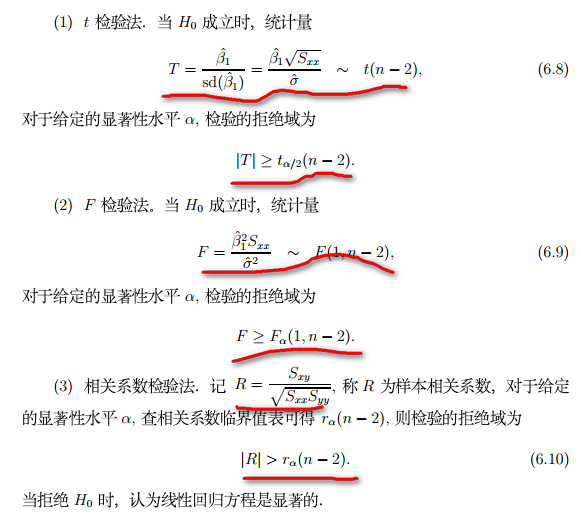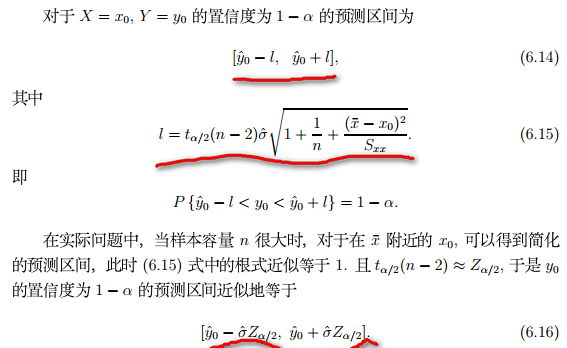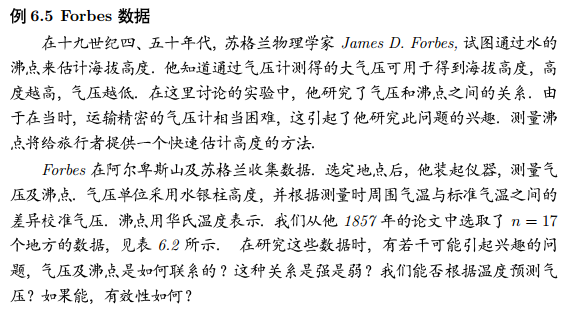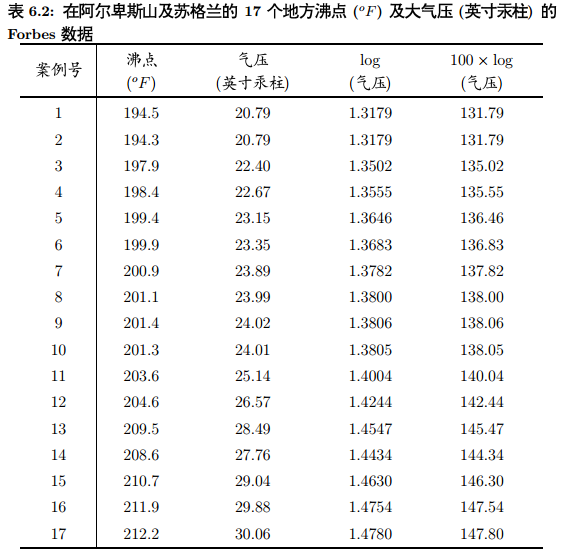回归分析
### 回归分析研究的内容
- 确定Y与X1,X2…间的定量关系表达式。称之为回归方程
- 对求得的回归方程的可信度进行检验
- 判断自变量Xj对Y的有无影响
- 利用所求的的回归方程进行预测和控制
一元线性回归
一元线性回归方程:

σ^2 最小二乘估计:
回归方程的显著性检验
假设检验: H0: β1 = 0, H1: β1 ≠ 0
通常采用三种方法来检验:

一元线性回归的简单例子:
> x<-c(0.10,0.11,0.12,0.13,0.14,0.15,0.16,0.17,0.18,0.20,0.21,0.23)
> y<-c(42.0,43.5,45.0,45.5,45.0,47.5,49.0,53.0,50.0,55.0,55.0,60.0)
> result <- lm(y~ 1 + x) #表示y = β0 + β1*x + ε
> summary(result) #用于提取模型的计算结果
Call:
lm(formula = y ~ 1 + x)
Residuals: # 残差分布情况
Min 1Q Median 3Q Max
-2.0431 -0.7056 0.1694 0.6633 2.2653
Coefficients: #系数
Estimate Std. Error t value Pr(>|t|)
(Intercept) 28.493#β0 1.580 18.04 5.88e-09 ***
x 130.835#β1 9.683 13.51 9.50e-08 ***
---
Signif. codes: 0 ?**?0.001 ?*?0.01 ??0.05 ??0.1 ??1
#残差标准差
Residual standard error: 1.319 on 10 degrees of freedom
# 相关系数平方
Multiple R-squared: 0.9481, Adjusted R-squared: 0.9429
# F的统计量
F-statistic: 182.6 on 1 and 10 DF, p-value: 9.505e-08
参数β0和β1的区间估计:
> x<-c(0.10,0.11,0.12,0.13,0.14,0.15,0.16,0.17,0.18,0.20,0.21,0.23)
> y<-c(42.0,43.5,45.0,45.5,45.0,47.5,49.0,53.0,50.0,55.0,55.0,60.0)
> result <- lm(y~ 1 + x)
> interval <- function(fm, alpha = 0.05){
+ A <- summary(fm)$coefficients
+ df <- fm$df.residual
+ left <- A[,1] - A[,2]*qt(1-alpha/2,df)
+ right <- A[,1] + A[,2]*qt(1-alpha/2, df)
+ rowname <- dimnames(A)[[1]]
+ colname <- c("Estimate","Left","Right")
+ matrix(c(A[,1],left, right), ncol = 3, dimnames = list(rowname, colname))
+ }
>
> interval(result)
Estimate Left Right
(Intercept) 28.49282 24.97279 32.01285
x 130.83483 109.25892 152.41074
现在呢,我们可以利用我们算出的回归方程来进行预测。预测的结果由两部分组成,一个是预测值,另外一个预测区间。我们可以利用R提供的predict函数来进行预测。

> x<-c(0.10,0.11,0.12,0.13,0.14,0.15,0.16,0.17,0.18,0.20,0.21,0.23)
> y<-c(42.0,43.5,45.0,45.5,45.0,47.5,49.0,53.0,50.0,55.0,55.0,60.0)
> result <- lm(y~ 1 + x)
> newdata <- data.frame(x = 0.16)
> predata <- predict(result, newdata, interval = "prediction", level = 0.95)
> predata
fit lwr upr
1 49.42639 46.36621 52.48657
实战一把:


> X<-matrix(c(
+ 194.5, 20.79, 1.3179, 131.79,
+ 194.3, 20.79, 1.3179, 131.79,
+ 197.9, 22.40, 1.3502, 135.02,
+ 198.4, 22.67, 1.3555, 135.55,
+ 199.4, 23.15, 1.3646, 136.46,
+ 199.9, 23.35, 1.3683, 136.83,
+ 200.9, 23.89, 1.3782, 137.82,
+ 201.1, 23.99, 1.3800, 138.00,
+ 201.4, 24.02, 1.3806, 138.06,
+ 201.3, 24.01, 1.3805, 138.05,
+ 203.6, 25.14, 1.4004, 140.04,
+ 204.6, 26.57, 1.4244, 142.44,
+ 209.5, 28.49, 1.4547, 145.47,
+ 208.6, 27.76, 1.4434, 144.34,
+ 210.7, 29.04, 1.4630, 146.30,
+ 211.9, 29.88, 1.4754, 147.54,
+ 212.2, 30.06, 1.4780, 147.80),
+ ncol=4, byrow=T,
+ dimnames = list(1:17, c("F", "h", "log", "log100")))
>
> forbes<-data.frame(X)
> plot(forbes$F, forbes$log100) #看看在散点图上,两者有没有什么明显的关系
>
> result <- lm(forbes$log100 ~ forbes$F)
> #看看线性回归方程的情况
> summary(result)
Call:
lm(formula = forbes$log100 ~ forbes$F)
Residuals:
Min 1Q Median 3Q Max
-0.32261 -0.14530 -0.06750 0.02111 1.35924
Coefficients:
Estimate Std. Error t value Pr(>|t|)
(Intercept) -42.13087 3.33895 -12.62 2.17e-09 *** #有很显著的差异了
forbes$F 0.89546 0.01645 54.45 < 2e-16 ***
---
Signif. codes: 0 ?**?0.001 ?*?0.01 ??0.05 ??0.1 ??1
Residual standard error: 0.3789 on 15 degrees of freedom
Multiple R-squared: 0.995, Adjusted R-squared: 0.9946
F-statistic: 2965 on 1 and 15 DF, p-value: < 2.2e-16
> #两个参数的区间估计
> interval(result)
Estimate Left Right
(Intercept) -42.1308708 -49.2476789 -35.0140626
forbes$F 0.8954625 0.8604095 0.9305155
> #散点图和直线方程的拟合情况
> abline(result)
> #观察残差的情况
> rr <- residuals(result)
> plot(rr)
> #发现第12个点有问题,那么要进行处理
> text(12,rr[12],labels = 12, adj =1.2)
>
> result_new <- lm(forbes$log100 ~ forbes$F, subset = -12)
> summary(result_new)
Call:
lm(formula = forbes$log100 ~ forbes$F, subset = -12)
Residuals:
Min 1Q Median 3Q Max
-0.21175 -0.06194 0.01590 0.09077 0.13042
Coefficients:
Estimate Std. Error t value Pr(>|t|)
(Intercept) -41.30180 1.00038 -41.29 5.01e-16 ***
forbes$F 0.89096 0.00493 180.73 < 2e-16 ***
---
Signif. codes: 0 ?**?0.001 ?*?0.01 ??0.05 ??0.1 ??1
Residual standard error: 0.1133 on 14 degrees of freedom
Multiple R-squared: 0.9996, Adjusted R-squared: 0.9995
F-statistic: 3.266e+04 on 1 and 14 DF, p-value: < 2.2e-16
总结:
一元线性回归求解的步骤: 1. 用plot看一下图形的情况,然后在写方程式 2. 对于求解出来的方程式进行验证,看看残差的情况,有没有异常的残差点。 3. 最后除去残差,重新计算方程式。
参考文献
1.《统计建模与R》
@This site is licensed under a Creative Commons Attribution-NonCommercial-ShareAlike 3.0 License@
